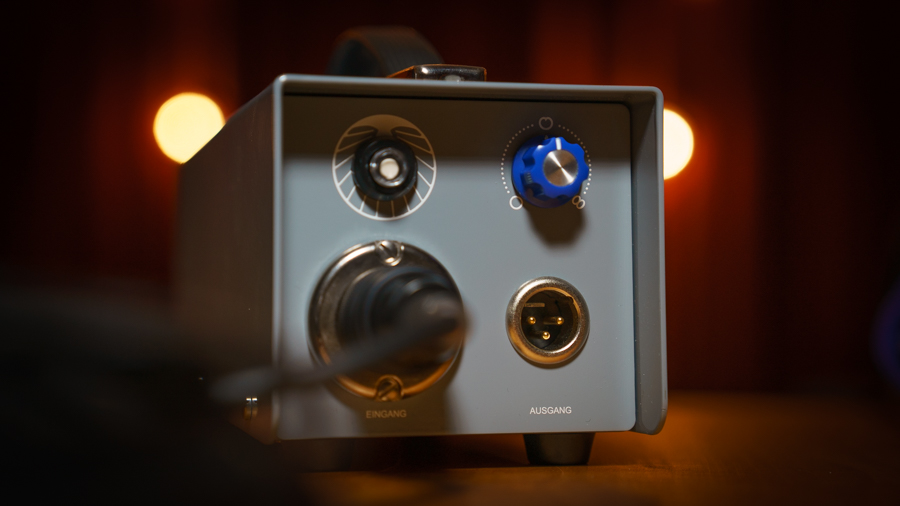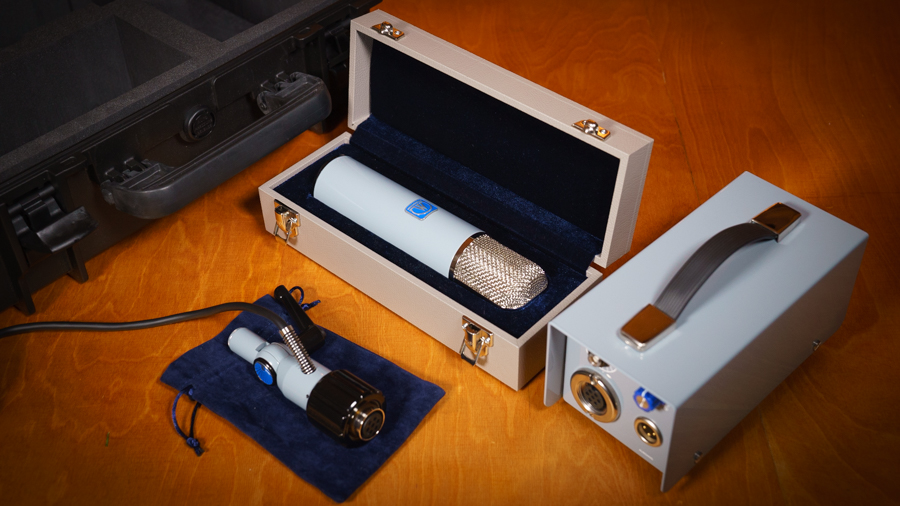What does an instant classic look like? This. The Myburgh M1 is a stunning tube condenser microphone with an M7 capsule and a military-grade long-life tube.
When a professional decides to choose a high-end microphone, the options start to slim down. I’m talking about something worth more than $6K, where you might say “Do I buy a car…or this?”
The obvious brands might come to mind, but it would be very wise to now consider the German company Myburgh. Their only product right now is the M1: a large-diaphragm tube condenser microphone featuring a German-made Mylar M7 capsule made by Siegfried Thiersch and a Russian military-grade long-life tube. We took this beautiful beast for a test in the studio.

When a Pelican-inspired, waterproof carry case arrived at the Happy studio, we knew this was a serious piece of professional audio gear. The Myburgh M1 is the realisation of producer, engineer and analog audio lover, Andrew Myburgh and was designed by world-renowned audio designers Andreas Grosser and Eckehard Dux.
It’s with a heavy heart that we inform you Andreas Grosser passed away mid-this year. Andreas was an extremely talented and committed technician who was one of the world’s few trusted people to work on vintage pieces. He bought that craftsmanship to the Myburgh M1. The team at Myburgh have reassured us they will continue on as planned upholding Andreas’ standards as close as possible.
Firing this microphone up, the first obvious choice was vocals. With some gracious help from alt pop artist Bambi O’Hara we dived straight into recording one of her new songs. She came in for a Live from Happy performance recently, you can watch that here: Bambi O’Hara – Religion (Live from Happy).
Keeping it simple yet classic we put the mic into a Universal Audio 6176 preamp. Having used a vintage Neumann U47 and U67 before on Bambi O’Hara’s vocals I’m no stranger to the character and quality they impart. I was instantly reminded that this microphone is of that ilk, but without the noise floor and careful setup. Not saying you shouldn’t be careful with the M1, but it’s a brand new unit so everything feels solid and hasn’t seen 50+ years of use.
We went for the standard cardioid polar pattern, however, on the microphone’s power supply unit there’s 2 other polar patterns of Figure 8 and Omni selectable via an indented potentiometer, and a true cardioid button.

Once connected to the swivel, It’s a big unit with an impressive modern-yet-classic design. The lead is a Mogami Neglex 3172 tube microphone cable 7 meters (23 ft), the power supply is one solid build — everything has that rainbow of calm blue colours to it, and it just sounds beautiful. To give more info to the curious, the mic has not one but two custom-built transformers; one in the mic and another in the power supply.
The clarity fo the vocals was second to none. Further to that, it was just so, very clean, but not that awkward clean. If you know what I’m talking about, it’s when something just doesn’t sound like it fits in the music.
Asking for a full range of vocals from low octave below doubles, low mid harmonies all the way up to high falsetto, the M1 handled each part beautifully. There’s an old production trick of using a different microphone for the backing vocals — for character — so I did that with a standard Neumann U87.
While these two microphones are not even close to being in the same price range — and the M1 is a tube condenser, it was really interesting to hear the difference. The M1 gives warmth and command, putting that vocal right in front of the recording, without even trying too hard. I am curious about the extended frequency range, and the true cardioid. This might be why it holds so much clarity.
Glamour, tone and accessories aside, I had one small issue. As we were tracking vocals, Bambi O’Hara moved her foot from the stool she was sitting on to the floor, which created one huge microphonic thump. While I was impressed by the extended low end — the microphone has a frequency range from 30 Hz – 20 kHz — I was reminded that there was no shock mount included in the package.
I know, I know, some tube condensers from yesteryear didn’t come with shock mounts, so I will yield on this point. If you want a shock mount for this, I would pickup one of these Rycote studio shock mounts if you intended to lessen the transmission of sound. Especially since Myburgh claim: “…handles SPL better than your favourite FET kick drum mic.” I would be keen to try that next time!
That teeny tiny issues aside, you will get what you pay for. It’s stunning in its sound and design. It’s an instant classic.
I was absolutely blown away by this microphone and I am seriously considering buying one. Once you hear it, it’s hard to go back…
The Myburgh M1 comes in at $6,495 USD ( Approx. $10,457 AUD) and for more details head over to myburgh.eu
The photos in this article were taken by the team at King St. Studios.



